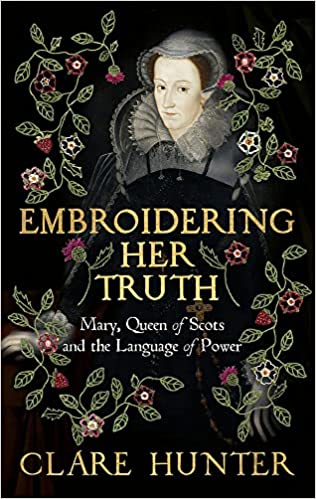Embroidering Her Truth: Mary, Queen of Scots and the Language of Power
(Sceptre, 2023); pbk, £10.99
Banner-maker, community artist and textile curator, Clare Hunter won the Saltire First Book Award for her debut work, Threads of Life (2019), which became Waterstone’s Scottish Book of the Month and a Radio 4 Book of the Week. Embroidering Her Truth continues this historical thread, weaving readers through episodes in Mary Stuart’s life, with an intricate examination of embroideries, tapestries, and textiles, and the subliminal messages these held.
In her non-fiction narrative, commended by the late Hilary Mantel, Hunter takes us through period history, rivalry between European kingdoms, and the parts played by rich tapestries, clothing and furnishing textiles in exhibiting wealth, opulence, and superiority. She reveals that the fortune spent on clothing the young queen in preparation for her marriage to the Dauphin represented her value to the kingdom. In the hall of Mary’s chateau, Hunter imagines the couple in their finest, ‘baptizing the floor of the ballroom with their dancing’ but by the end of the first chapter the Dauphin is dead, and Mary no longer useful to the French. Hunter traces history through objects, buildings, archives, and expertise, often drawing on her own experiences and using first-person narration.
Reformation society is described through the ornate clothing and decor of the Catholic Church, and the challenge posed by Protestants in their destruction of property and holy relics. Rescued textiles became valuable as they were thought to be a Christian-spiritual talisman. Such gifts held strong symbolism which Hunter illustrates with pathos, through the example of the Fetternear Banner. She deconstructs the discourse on Knox’s challenge to female monarchs, which sends chills through the heart, but while Mary is conciliatory in her dealings with Knox, her luxurious coronation clothing speaks volumes.
Hunter shares fragments from her own life in every chapter – fascination with Mary through a school project, embroidery on the sleeves of her first communion dress, the burning of childhood objects as her mother made room for a life without their father. One doll survived and acted like a touchstone between the familiar and the unknown, Hunter’s poignant, biographical details leading into a discussion on the importance of dolls as gifts that demonstrated etiquette, court life and female empathy in the 16th century. With her interest in culture and fashion, Mary was at the vanguard of change and a subtle rise in female strength. The ‘language of power’ such as the exchange of dolls held influence.
Mary’s marriages, births, betrayals, conspiracies, alleged plots, imprisonment, and execution are articulated through the language of clothing and textiles as her story begins to unravel in the final chapters. Viewing Mary’s needlework, brings Hunter closer than ever to the presence of the sovereign as she examines her ‘Catte’ embroidery outside of its glass, and comes away with a great sense of admiration for the queen. Mary was writing her life into this work where a large ginger cat holds down a trapped mouse with its paw; in a subtle sub-narrative, Hunter does the same, braiding episodes from her own life into this work.
A dramatized version of Mary’s life and death, recalled by the author, relates how, in her lack of material wealth and power towards the end of her life, the Stuart monarch begins to portray herself as a Catholic martyr. Her captors deny Mary such tropes, but she defies the odds, parading to her execution block, and revealing scarlet sleeves and petticoat beneath her black gown. Such a powerful spectacle is forever dominant in the final portraits of Mary.
How we retain and reframe the past, according to our present is shown in the ultimate chapter, in examples of the changing displays in Mary’s chamber in Holyrood House, and through the discourse surrounding her letters and sewn objects. Until recently, Hunter reflects, the latter were not valued by collectors or museums; however new interpretations bring these to recognition, and some are beginning to attain talisman like qualities themselves, which is excellent news as these items deserve recognition for the fascinating stories they hold.
Loretta Mulholland


Fascinating blog. I love the idea of textiles having meaning beyond financial value and needlework skills alone.